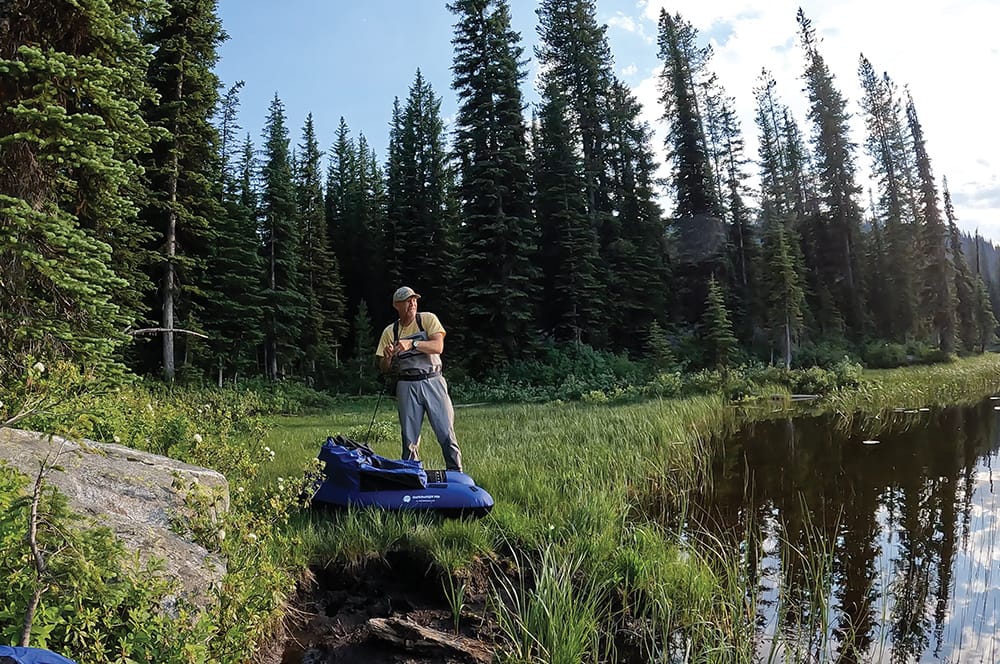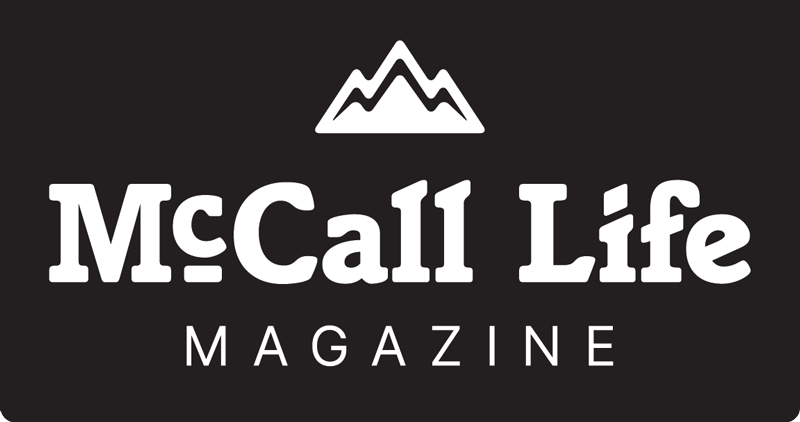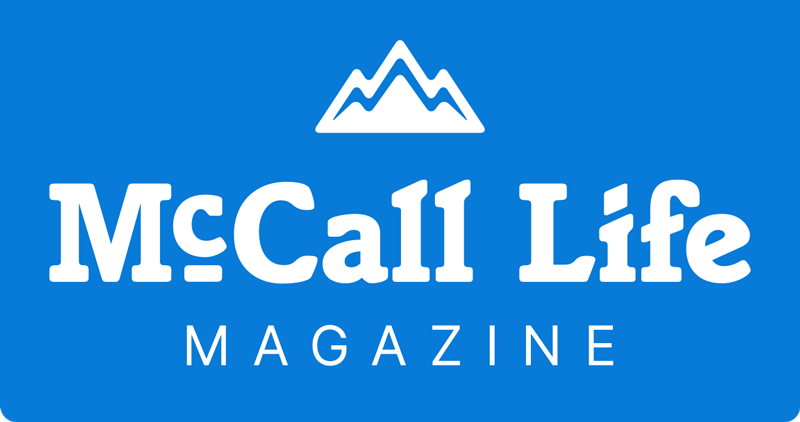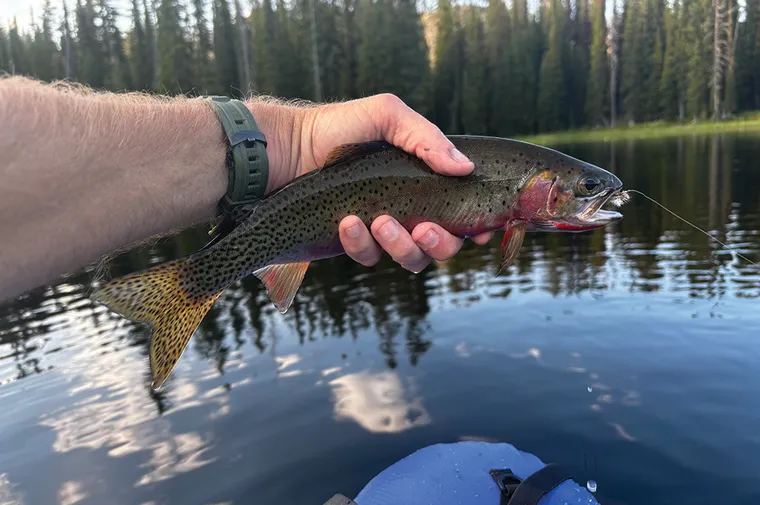Fishing high alpine lakes
“Oh, My God!” I yelled for the umpteenth time. “Fish on!”
My buddy, Rod, floating nearby, just laughed. “Doesn’t get better than this,” he said.
Agreed.
Hatching A Plan
The plan, like most plans here in McCall, was hatched over texts.
“Yo,” texted Rod, “Want to fish a high mountain lake tomorrow?”
“You bet,” I texted back.
It was game on.
So, we went back and forth a bit, setting a time to meet, picking the lake we wanted to hike into, and letting our wives know when we would return.
I spent the night organizing my gear—not a big job since it was midsummer, and I tried to fish these lakes a couple times a week—but I did need to tie up some more black ant patterns. And, let’s be honest, getting ready for a fishing trip is almost as much fun as going on the trip. Almost.
So, I hunkered down, tied some flies, packed my gear into my car, and went to bed.
The next morning dawned crisp and sunny. I made some coffee, grabbed my car keys, and headed towards Rod’s house. The plan was to drop my car there so we could drive up together.
Hitting The Road
Pulling into Rod’s driveway, I was met by his dog, River, seemingly as excited as we were to do a little fishing.
“What’s happening?” I asked as I got out of the car.
“Not much,” Rod said. “Ready to go?”
“You bet.”
So, I loaded my stuff into the bed of his truck and off we went.
The ride to the trailhead would take an hour, so we drank coffee, chatted about our fly selection, and basically shot the shit as the road got worse and the country outside our window grew more beautiful.
Eventually, we pulled into the trailhead, threw on our backpacks, and started hiking. Our lake of choice was about three miles from the trailhead—a fairly well-worn path went up and over a hill, down a drainage, over another hill, and eventually to the medium-sized alpine lake tucked up against a slab of granite.
As we walked down the last pitch, crossing a scree of boulders, we found the deep, blue lake and a nice place to launch our float tubes.

The Secret To Success
Ah, yes, the float tubes—I forgot to mention them. These ultra-light, backpacking tubes have been a game-changer for our alpine lake fishing trips. No more trying to wade into the muck of the lake bottom, hoping to avoid losing a shoe. No more tangling my back cast in a tree. And, most importantly, no more watching fish jump in the middle of the lake with no way to reach them.
Rod and I dropped our packs, pulled out our float tubes, and inflated them. Within minutes, the tubes were ready to go. Setting them aside, we pulled on waders, rigged our rods, put on our flippers, and pushed offshore.
Rod headed to the other side of the lake, under the impression that the fishing is always better farther away from where you currently reside. I floated out about 10 feet and started casting. Immediately, my ant was devoured, and I started hooting and hollering. The first cutthroat of the day pulled me away from shore as it fought and dove, trying to get away.
Patiently, I let out the line, playing the fish till he tired and swam more willingly into my net. With a flip of the wrist, I scooped him up, always amazed at how awesome it is to net a fish while sitting in the water, staring him in the eye.
With the flick of a finger, the barbless hook released, and I said goodbye to my first catch.
I looked up to see Rod laughing and reeling as his rod bent under the weight of another nice cutthroat. The day just got better and better.
At one point, I tangled my line around the tip of my rod while landing yet another lunker. As I went about unwinding it, my fly, unknown to me, was floating in the water next to my tube. Suddenly, the line I was unwinding went taut. Fish on. Crazy. I hand-lined the fish to my net, unable to use my rod because the line was still wound around the front guide.
Finishing Strong
The day continued, and the fish stayed active. Rod and I stayed in the cold water as long as we could—maybe a little longer than we should have—but eventually, we headed to shore. We stripped off our waders, deflated our tubes, repacked our backpacks, and settled down in the sun to have a quick snack.
“That was amazing,” said Rod.
“Agreed,” I said. “I haven’t had many days that good in my life.”
And it was true. While there’s no doubt that the high mountain lakes surrounding McCall are home to some amazing cutthroat, rainbow, brown, bull, and brook trout, there’s also no doubt that they don’t always cooperate, no matter how far you hike to find them.
All fueled up, Rod and I shouldered our packs and started the hike out to the truck. It was another great day in this amazing place.
If you’re interested in using a float tube to reach those fish in the middle of the lake, I recommend the Wilderness Light Backpacker Pro (https://wildernesslitefloattubes.com/).
If you want to see how they work, check out our YouTube channel, @McCallLife.
How To Plan Your High Lakes Fishing Trip
Perhaps the best part of any trip is creating the plan. It might sound stupid, I know. But my experience has involved sitting around the kitchen table, laptop up and running, beer at my side, maybe a buddy or two joining me—it’s all part of the fun of fishing trips.
There are generally two ways trips come together. One is traveling with a mentor or somebody who has already fished the water you’re heading to. They have all the intel and experience, so instead of starting from scratch, you’re only making micro decisions—looking at weather windows, work schedules, and the best approach route to the water.
The second way trips come together is from scratch. If this is you, then you need to say a silent “thank you” to Idaho Fish and Game. The department has done the work for you.
According to Jordan Messner, Regional Fisheries Manager for the Idaho Department of Fish and Game, the department has created an online trip planner tool (scan the QR code below for access). Just search for the lake you’re looking to visit, and voila, all the data you need. The trip planner pulls up a map and geolocates the lake for you. The map offers layer options like Onyx Hunt or your favorite GPS app, plus it augments the data with fish and game information like the complete stocking record, any survey data from the last time biologists studied the lake, and even information from folks who have visited recently. It’s an amazing tool.
Messner says Idaho Fish and Game stocks about 160 of the 400 high mountain lakes in the McCall region on a three-year rotation. So, every year, roughly 52 high mountain lakes are stocked with cutthroat, rainbow, and grayling. All this information is in the trip planner—so you can decide if you want to fish a lake that was stocked last week, last year, two years ago, or never. According to Messner, fish aren’t even a year old when stocked, so he says it’s best to wait 3 or 4 years for them to grow.
If you use the trip planner and want to help Fish and Game keep tabs on the success of its stocking strategy, send an email or give local biologists a call when you return and share what you found. If you fished a lake that was stocked with three species of fish but only caught rainbows, the team wants to know that. If you didn’t see or catch anything, they want to know that, too.
But, as Messner says, the most important thing is to have fun and spread the love of fishing to the next generation. Always use best fish-handling practices—but don’t let them get in the way of snapping a picture of your kid with their trophy trout.
“We work hard to keep our populations healthy, but we really want you and your friends to enjoy our work. So, get out there and have some fun,” Messner says.
Now that’s good advice.



